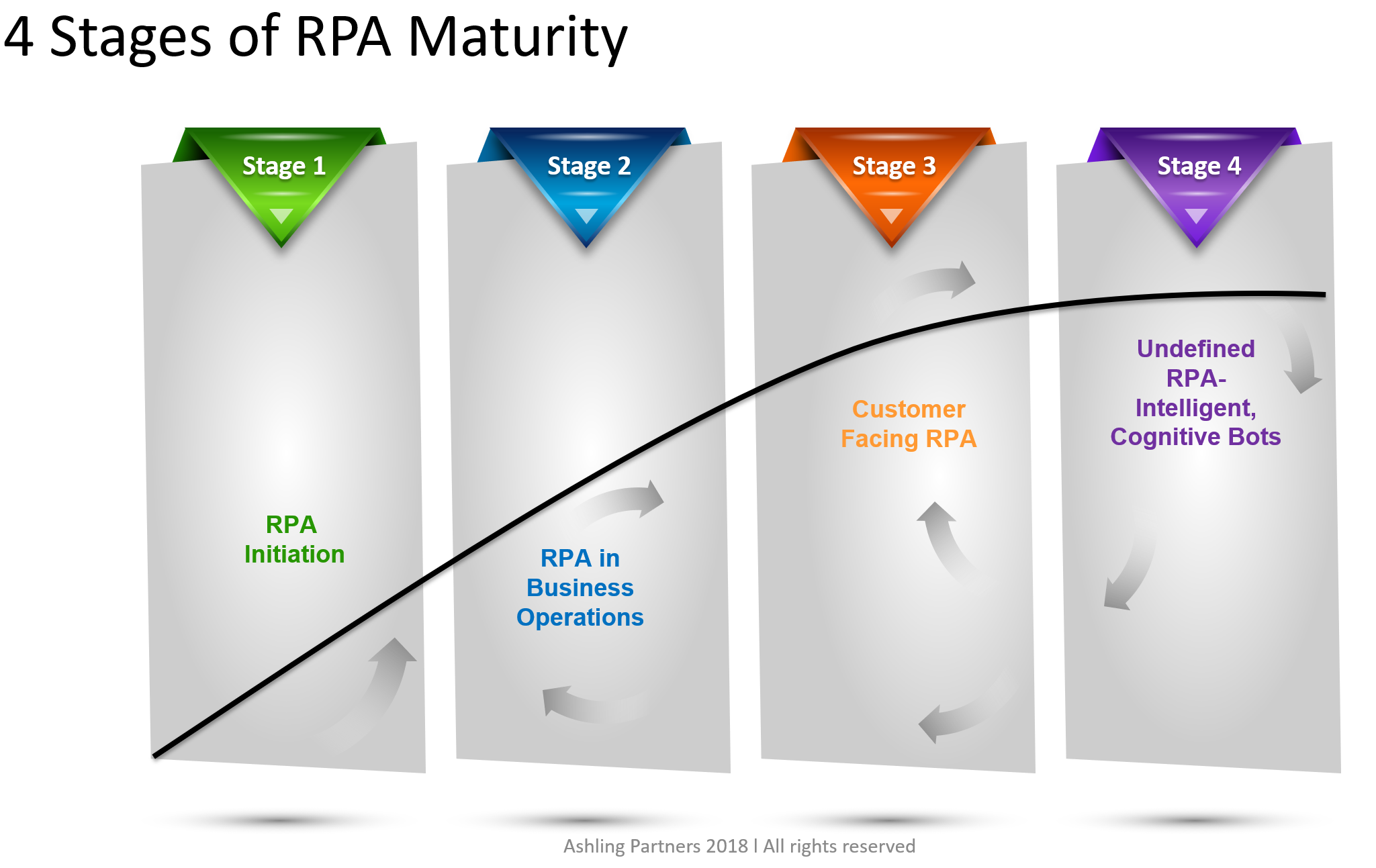As we have seen more and more clients get engaged in Robotic Process Automation (RPA), we have found that it is a well-received starting point for many organizations to “dip their toe” into Artificial Intelligence. But what’s the future of RPA? Many organizations have read articles or heard about AI – a very popular topic of conversation – but many struggle to understand tangible use cases that drive business value.
In a prior blog, we define RPA and emphasize that it is focused on task automation within a process. Large amounts of technology vendors and consulting firms are already moving away from the term RPA and utilizing a version of the term Intelligent Process Automation (IPA). This is largely because it focuses on the “intelligent” capabilities within RPA, versus the original concept of RPA, which is administrative, thoughtless tasks that are repeated over and over. IPA starts to emphasize some of the cognitive capabilities within the process automation software.
Four Stages of RPA Maturity
We see multiple phases of the maturity of RPA/IPA within an organization. We describe them below:
Stage 1 – Initiating RPA:
When organizations start thinking about improving their efficiency and removing redundant tasks, they usually begin with areas that are very rule-based and static (meaning the process does not change). For most organizations, the easy answer is in their back-office processing. It is even better if they have a shared services group running the back-office processes. Examples of these are AP Invoice Processing, employee on-boarding, expense submission and reporting, etc. I would never say 100% of the time, but in many cases, this is where many organizations start because it is a very repeatable, structured and static process that probably is not a differentiated service in your organization…meaning it is less risky than a customer-facing process to your business.
Stage 2 – RPA for Business Operations:
Once an organization has demonstrated value in the back-office, many turn to the operational processes that may be less static but still significant scale in volume and therefore easy to prove out the business case. This is the core part of the business and may be automated for 2 reasons: reduce cost / increase efficiency or remove mundane, repeatable tasks from your employees to keep them better engaged in the more value-added aspects of your business. Examples of this are vendor selection & management, inventory management, and supply & demand planning.
Stage 3 – Customer-Facing RPA:
Although some organizations are already automating the customer experience, most companies are more risk-averse to put automation in front of clients (except for call routing and support) due to the negative ramifications it could possibly have. People are waiting to see successes and more maturity in the model before they risk a customer interaction. However, others are jumping in and creating the “One Office” model where there no longer is a front office and back office but one complete process flow that is centered around the customer experience. Many “digitally native” companies are built to embrace technology with the end-customer as the priority. Other, older and more established organizations are struggling to break down old silos and batch processes to become more customer facing and are attempting to resolve this with a digital transformation that includes “One Office” for a fully automated process flow throughout the lifecycle of the customer engagement. RPA is a great initiator of this process.
Stage 4 – Undefined RPA- Intelligent, Cognitive bots:
As organizations mature with automation as part of their process efficiency, they look to smarter bots to do even more work with less reliance on human interaction. Technology vendors are rushing to include more and more capabilities into their tools. Over time, this includes predictive algorithms. These “smarter” bots may be replacing the earlier bots with even more improved process quality & overall process efficiency. This is a newer space and many organizations that we engage with are just starting in this phase as in an explorative manner, or still trying to build momentum in the organization to get to this state. This is certainly the growth area for IPA and how organizations will evolve their automation activities into more AI-centric activities.
Going forward
RPA/IPA technology is turning into a platform where solution partners will need to provide creativity in identifying use cases for process improvement and automation areas as well as industry understanding to help companies move past some of the easier/obvious examples of automation. The value will be in bridging the maturity from automation to AI in a digestible journey. This will take an understanding of their business and some creativity in use cases, shifts in mindset and culture, and future process design. As we stated HERE, the future will put more value around creative skills and story tellers.





